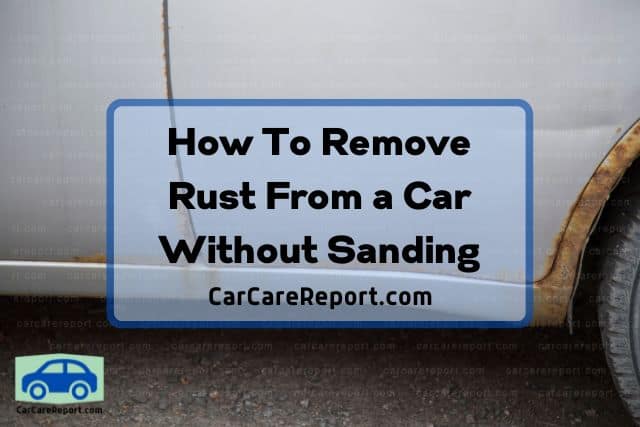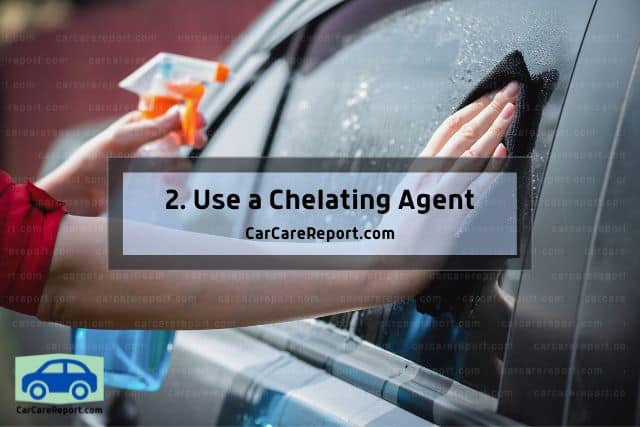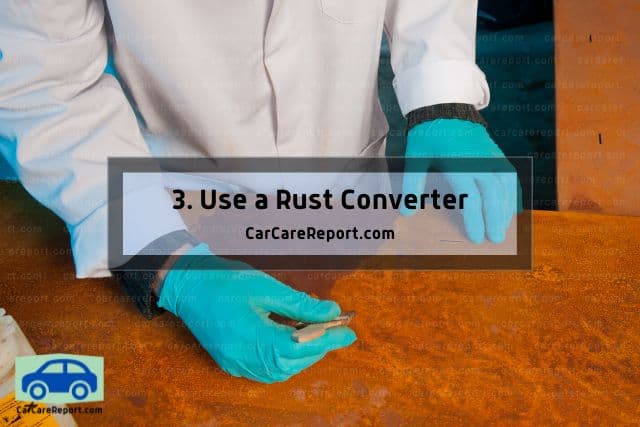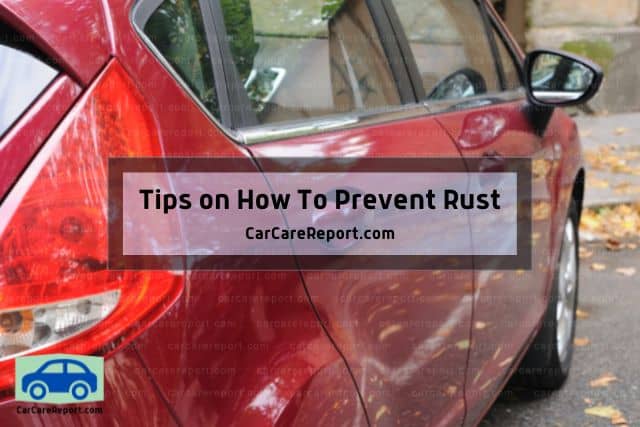A car’s aesthetic is a pretty big deal, and there’s no shortage of threats to its finish. For one, rust is an inevitability for anything made of metal, and it can spread when not checked. Fortunately, there are simple and effective ways to address this.

Here are 3 ways you can remove rust from your car without sanding:
- Use a chemical remover.
- Use a chelating agent.
- Use a rust converter.
There are also some factors to consider if you’re to remove rust from your car successfully. In this article, I’ll help you better understand how these different types of rust removers work and how to prevent rusting in the first place.
1. Use a Chemical Remover

Rust is essentially the coming together of iron, water, and oxygen. When all three elements are present, a chemical process ensues. The water and oxygen act on the iron, corroding it and turning it into iron oxide or rust.
If addressed quickly enough, this unsightly red blemish can be removed — and without sanding. To do that, you’ll need a chemical remover. There are two types you can turn to:
- Acids
- Petroleum-based solvents
Each one of these has different properties and mechanisms of action. Let’s take a closer look at them.
Acids
Acids are the stronger and faster-acting of the two chemical removers. However, acids are also more toxic. When applied onto a rusted surface, a chemical reaction occurs in which the acid works to loosen the rust’s bond to the surface.
There are two types of acids, the strong acids, and the weak acids. The strong acids are the mineral acids such as sulphuric acid and hydrochloric acid, while the weak acids include the following:
- Phosphoric acid
- Tannic acid
- Oxalic acid
- Acetic acid
- Citric acid
- Ethylenediaminetetraacetic acid (EDTA)
The strong acids are highly corrosive mineral acids that react by dissolving rust. They work much faster and can get the job done in a matter of hours, sometimes even minutes.
However, there is a downside to this.
These chemicals are caustic and will not stop with the rust. So, they may cause further damage to the surrounding area and the metal surface beneath the rust.
On the other hand, weak acids are a safer, albeit slower, bet. Additionally, the name can be a bit misleading and give one pause.
Weak acids don’t give a weak reaction per se. Simply put, they can get the job done in a gradual and less destructive manner.
By contrast, strong acids or mineral acids are more volatile, especially at higher concentrations. With weak acids, you have greater control of the reaction taking place.
Sure, it will take more time. But chemical removers using weak acids in their formulation will eventually clear up the rust with minimal risk of damage to your car and your health.
Petroleum-Based Solvents
Some of the most effective chemical rust removers are petroleum-based solvents. The best example of this is WD-40.
Chances are, this product is familiar to you. Its signature blue and yellow can is a common feature in garages, service stations, and petrol stations.
Even slower than weak acids, petroleum-based solvents make use of pressurized gases for the dispersal of rust.
While they are effective, they take time to loosen the rust’s bond to the surface of your car. Some petroleum-based solvents can take up to 24 hours at the very least to get results.
But, don’t let that put you off these products. When the full course is up, they’ll have your rust problem solved.
Chemical Remover Preparation
With their easy-to-use products, manufacturers have simplified the task of removing rust so every car owner can now get the job done.
However, this ease is offset by the dangers these chemicals pose. So, the very first thing you’ll want to do before taking on the rust is to put on protective equipment, including:
- Gloves and apron. These will keep your skin safe from direct contact with harmful chemicals, especially strong acids.
- Mask. You’ll need to wear a mask to prevent inhalation of fumes that may have short-term to lasting ill effects on your health.
- Goggles. The last thing you’ll want is to get acid in your eyes. To prevent that from happening, be sure to put on a pair of goggles.
Chemical Remover Application
- Clean the affected surface. You may use soap and water with a sponge or brush to remove grease and dirt before applying the chemical remover.
- Apply the chemical remover onto the rusted area. Depending on the product, you’ll need to spray or daub it on. Be a bit liberal with it to get more thorough results, but not overly generous to risk damage.
- Use a scouring pad to remove the rust. Again, this will depend on the specific product you use. Some may require scrubbing, while others need no assistance and just have to be left on the surface.
- Leave the chemical remover on the rusted surface. Different products will specify different lengths of time. Be sure to check the labels of the product you are using and also take into consideration the extent of rust damage you are dealing with.
- Thoroughly rinse off or wipe down the chemical remover from the surface. The chemicals may continue to react with the surface even after removing the rust, causing more damage. Rinse it off or wipe it thoroughly to prevent this from happening.
- Apply a corrosion inhibitor. This type of formula can prevent corrosion from taking place and protect your car from more issues with rust.
2. Use a Chelating Agent

Chelating agents are easily the safest option available when it comes to rust removal. And that’s primarily because they’re acid-free.
These water-based solutions are relatively harmless — to your health, the environment, and your car’s surface beneath the rust.
They also go by the following names:
- Chelants
- Chelators
- Sequestering agents
Whatever you prefer to call them, you can’t go wrong with chelating agents.
Chelating agents form bonds with the ions of metals, including:
- Copper
- Lead
- Manganese
- Calcium
- Iron
Such metals have chain-like chemical structures. In this particular case, the chelating agents attach themselves to the ends of iron’s chain structure.
The molecules of the chelating agents prevent the iron ions from behaving as they normally would, and they draw the iron molecules away from the car’s surface and to a medium such as a solution in a rust removal bath.
Moreover, the attachment of the chelating agents’ molecules to the chain-like chemical structure of iron results in the formation of stable rings that allow these new molecules to pass through different environments with relative ease.
For these reasons, chelating agents are able to loosen the bonds of rust to metal surfaces and draw them away.
Chelating Agent Preparation
Chelating agents are generally harmless. However, donning some protective equipment is still advisable.
Breaks in the skin may become irritated and painful upon contact with the formula, or certain ingredients may be allergens to some and trigger an allergic reaction. Therefore, it’s best to put on protective clothing (such as gloves or goggles) before applying the product.
Chelating Agent Application
- Clean the affected surface. You may use a sponge with soap and water to remove grease, dirt, and debris from the area where the chelating agent is to be applied.
- Apply the chelating agent onto the rusted area. Depending on the product, you’ll need to paint or daub it onto the affected surface.
- Leave the chelating agent on the rusted surface. The length of time will vary by product. Follow the instructions indicated on the label of the particular one you’re using, with consideration for the extent of damage the rust has caused.
- Thoroughly rinse off or wipe down the chelating agent from the surface. Some of the soluble chelates formed may themselves initiate corrosion, so it’s important to clean the chelating agent off the surface after the desired results have been achieved.
- Apply a corrosion inhibitor. Some corrosion inhibitors have chelating agents among their ingredients. Note, however, that these are different formulations from the chelating agents used for rust removal.
3. Use a Rust Converter

There are cases where the rust problem has gotten so bad that chemical removers and chelating agents just won’t cut it. That’s where rust converters come in.
When applied directly to rusted surfaces, rust converters initiate a chemical reaction that converts iron oxide into a black coating that serves as a primer to be painted over.
Rust converters contain only two active ingredients:
- Tannic acid
- Organic polymer
The tannic acid is responsible for the black coating. It converts the red iron oxides we know as rust into stable ferric tannates that have a dark bluish-black color, and it’s this colored coating that becomes your primer.
You’ve no doubt realized that using a rust converter eventually results in more work than the previous two options. But, that’s the price to pay when rust has been allowed the time to build up.
Rust converters are your last resort of the three options outlined in this article. They take up more time and physical effort as required by the extent of the damage dealt to your car.
The alternative is to get the damaged area replaced and refitted by a professional. So at the end of the day, using a rust converter isn’t the most convenient option, but it will still save you a lot of money.
Rust Converter Preparation
Rust converters do not pose the same level of harm that chemical removers do. But, using protective gear is strongly advised nonetheless. Protective gear to wear when applying a rust converter may include:
- Goggles
- Gloves
- An apron
- A mask
However, simply wearing long-sleeved clothing and gloves should suffice, as they will keep your skin from coming in contact with the product.
Rust Converter Application
- Clean the affected surface. Remove any dirt or grease with soap and water before applying the rust converter formula.
- Apply the rust converter onto the rusted area. Some products will instruct you to use a paintbrush, while others will call for a paint roller.
- Leave the rust converter on the rusted surface. The length of time should be indicated in the instructions section on the product label.
- Apply additional coating. You may need to apply another layer for the best results. However, note that while it will take only a few minutes for the coat to dry, it will take 24 hours for it to fully cure.
- Paint over the affected area. After the conversion, there will be a black coating in place of the rust. This is a primer that you can paint over to completely restore the appearance of your car.
Tips on How To Prevent Rust

Iron oxide is a progressive automobile cancer. Those little blemishes on your car’s fender can quickly encrust its entirety.
CarCareReport dot com is owner of this article and was first posted on Sep 19, 2022 and was updated on ..
And while chemical removers, chelating agents, and rust converters can halt the process, preventing it in the first place is still the best option you have.
The old adage “prevention is better than cure” is wisdom to be applied not only to your own health, but to your car’s as well.
Fortunately, you can prevent that unsightly red crusting from engulfing your car and causing irreversible damage to it.
Here are a few tips on how to prevent rust:
- Regular cleaning. The elements essentially encourage the formation of rust. But for car owners such as those living along the coast or in the Northern Hemisphere during winter, the conditions are even more conducive. Regular cleaning can help prevent corrosion.
- Regularly apply a corrosion inhibitor. There are corrosion inhibitor products available on the market that are formulated to protect your car and inhibit the formation of iron oxides. Apply this to the surface of your car’s body as frequently as directed.
- Regular inspection. Parts of your car may still corrode despite regular cleaning and the application of a corrosion inhibitor. So be vigilant and nip rusting in the bud with a chemical remover or chelating agent.
Final Thoughts
Rust is not only an eyesore. It can spread and cause further damage to the metal surfaces of your vehicle. While sanding is one of the common ways of removing rust from a car, some would instead opt for less physically demanding and less damaging methods.
First published on Sep 19, 2022 by CarCareReport.com.
To that end, using a chemical remover, chelating agent, or rust converter is your best option. There are commercial products for each of these readily available in hardware stores. However, remember to wear the necessary protective equipment when working with these formulas.
Related Articles
Is Using a Clay Bar Worth It? The Facts Explained
How Much Does It Cost To Wax and Buff Your Car?
Buffing VS Waxing a Car: The Differences Explained
4 Important Differences Between Clay Bar Types
CarCareReport dot com first published this article on Sep 19, 2022..
